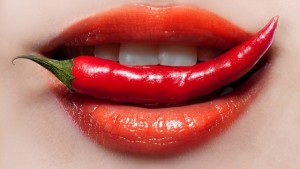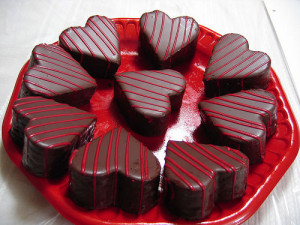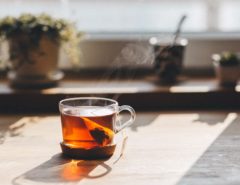By: Elizabeth Clark
Valentine’s Day is a holiday notorious for evoking strong emotions in people. Now for some, these emotions include disgust, depression, and a downright loathing for all things romantic or associated with February 14th. For most people, this day inspires a more magical ambiance due to the warm feelings of love, lust, and passion expressed between lovers. As a food scientist and OFG (official food geek), I exhibit a passion for food, but did you know that food has the ability to elicit passion in people? There exists a selection of foods that ACTUALLY educe emotions of passion and rouse people to be more intimate?

Foods “aphrodisiacs”, named after the Greek goddess of love, Aphrodite, are substances that increase libido when consumed. Throughout human history, men and women have sought out agents that can arouse and increase sexual response and desire. While many alleged aphrodisiacs are only the product of folklore, several do have scientific merit to support their claim of inducing lust. To assess whether or not an aphrodisiac works, it is important to understand what happens in the brain when sexual arousal occurs.

Tom Hardy courtesy of Giphy.com
Hormones, specifically testosterone, control sex drive in both men and women. When a person encounters something sexually stimulating via the five senses (touch, sight, smell, hearing, and taste), a chain reaction is set off throughout the body to provoke a response. Signals are sent from the limbic lobe of the brain through the central nervous system to the pelvic region telling the blood vessels there to dilate. This dilatation causes enlargement of sexual specific tissues in the groin as well as an increase in heart rate. While this tissue enlargement occurs, the brain releases the neurotransmitters norepinephrine and dopamine, both of which tell the body the experience it is undergoing is pleasurable.

Image courtesy of Loretta Graziano Breuing
Now aphrodisiacs can work in two ways: they can create sexual desire by affecting parts of the body or by the brain. Stimuli that cause physical stimulation, which increases blood flow to sexual tissues, is an example of the former while stimuli that cause the body to produce more of the chemicals associated with sexual desire is an example of the latter. Likewise, alcohol and other stimuli that lower inhibitions can also encourage lusty emotions. Food aphrodisiacs elicit feelings of passion either because their shape is arousing or because consuming them causes the body chemically respond. Bananas, avocados, carrots, cucumbers, and figs are considered aphrodisiacs because they resemble parts of male or female genitalia and stimulate our sense of sight. The scents of certain aromatic foods like cucumbers, basil, ginger, and licorice have also been implicated in generating sexual arousal via our physical sense of smell. Foods contain chemicals that, when they come into contact with the body, ignite a series of responses that can induce a sexual response.

Image courtesy of redchillishop.co.uk
For instance, chili peppers contain a substance called capsaicin that generates physiological responses including sweating, elevated heart rate, and increased circulation. Since these responses are similar to those experienced during intercourse, they can trigger the body to expect similar events are about to ensue. Similarly, other foods like garlic, ginger, and cardamom (which can be applied topically to specific areas) affect the circulatory system by increasing blood flow and can thus put people in the mood for love. Oysters, bananas, and pine nuts, which contain B-vitamins, zinc, D-aspartic acid, and other compounds essential to sex-hormone production/release, are considered aphrodisiacs. Likewise, aphrodisiac foods include those that contain estrogen, testosterone, or estrogenic (meaning that the compound acts as the hormone estrogen does) chemicals; examples of these include papayas and aniseed.

Image courtesy of specificmoments.com/
Think foods associated with Valentine’s Day are just a coincidence? Think again! Those heart shaped boxes of chocolates serve as more than a thoughtful, sweet treat. Chocolate contains phenylethylamine and serotonin, which are “feel good” chemicals that occur naturally in the body and are released by the brain when we feel happy, loving, or passionate. By giving chocolates to your Valentine, you could spark the flame of romance leading to a passionate celebration of the holiday. For those couples celebrating this day of love by getting married to their “honey”, you too could be under the effects of a food aphrodisiac. Honey, a common ingredient in wedding cakes and treats, is high in B-vitamins (needed for testosterone production) and boron (helps the body metabolize and use estrogen) making it an aphrodisiac. Coincidentally, the term “honeymoon” refers to the “honey month” celebrated by the newly weds of ancient Persia; newly-wed couples would drink mead (a fermented drink made with honey) the entire month following their nuptials to put them in the right frame of mind for a successful marriage.

Courtesy of Giphy.com
All in all, food has a long-standing history with love. Whether you choose to celebrate Valentines or not, you can at least celebrate relationships and the passion humanity has with food.
References:
Elizabeth West, Michael Krychman, Natural Aphrodisiacs—A Review of Selected Sexual Enhancers, Sexual Medicine Reviews, Volume 3, Issue 4, October 2015, Pages 279-288, ISSN 2050-0521, http://dx.doi.org/10.1002/smrj.62.
http://science.howstuffworks.com/aphrodisiac.htm
http://www.cosmopolitan.com/sex-love/advice/g1022/aphrodisiac-foods-0509/?slide=1
http://www.webmd.com/sex-relationships/features/want-better-sex






If your libido is not what it once was lately, the cause could be your eating habits. Obviously, you are less in the mood when you are tired or have a lot on your mind. Having a low libido as a man or woman is incredibly frustrating. Fortunately, there are several (natural) foods that can increase your libido. A food that has a direct aphrodisiac effect is called an aphrodisiac. Figs, bananas and avocados are examples of natural aphrodisiacs full of vitamins and minerals that increase blood flow to the genitals and libido. Another good example of a natural aphrodisiac is dark chocolate. You can discover more aphrodisiacs on https://ladykiller.nl/afrodisiaca/. In addition to nutritional products, there are a number of natural supplements that can make a positive contribution to libido. One of the best known is maca. Several studies have shown that this plant herb increases sexual desire, both in men and women. In addition, it has a positive impact on women’s hormonal balance and fertility. Another natural supplement that contributes positively to a healthy libido is ginkgo biloba by improving blood flow to the genitals.